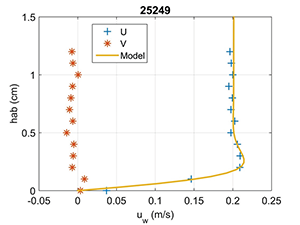Bottom Boundary Layer Model (BBLM)

Description: The Bottom Boundary Layer Model (BBLM) is used to compute the bottom shear stress components in combined wave and current flows using a modified form of the Grant-Madsen-Glenn-Styles famly of bottom boundary layer models. The code uses a 3-layer analytical eddy viscosity computation as described by Styles and Glenn (2000), but without the correction for suspended sediment induced stratification. The model is designed for time series input and computes the time average shear stress, the maximum shear stress for the wave, and the maximum combined shear stress for the wave and current. The model also predicts the suspended sediment concentration for non-cohesive sediments for an arbitrary number of individual grain size classes. A second routine is included that generates vertical profiles of the current, suspended sediment concentration, and sediment transport, which can be input into graphic generating software (MATLAB, Excel, etc) for plotting. The program is coded in MATLAB and the user must have access to the basic MATLAB software to run the model.
Benefits: The BBLM can provide scoping level assessment of the importance of waves versus currents in contributing to sediment mobilization. It is a modular code that can be implemented either as a stand-alone application or as the bottom boundary condition in 2-D or 3-D shelf circulation models.
Application: The model has been used to delineate the effects of waves versus currents in resuspending bed material in vegetated coastal wetlands, as well as assess long-term sediment mobilization and transport pathways in coastal areas. It has also been used as an instructional tool in upper level undergraduate and graduate courses focusing on coastal processes and coastal engineering.
Documentation and Support
Test Case & Files
- MATLAB Application files (.zip file)
- Test Case Data File (.zip file)
- Test Case Documentation (.pdf)

 Home
Home
 Products
Products Publications
Publications Tech Transfer
Tech Transfer Wiki
Wiki
 CIRP
CIRP